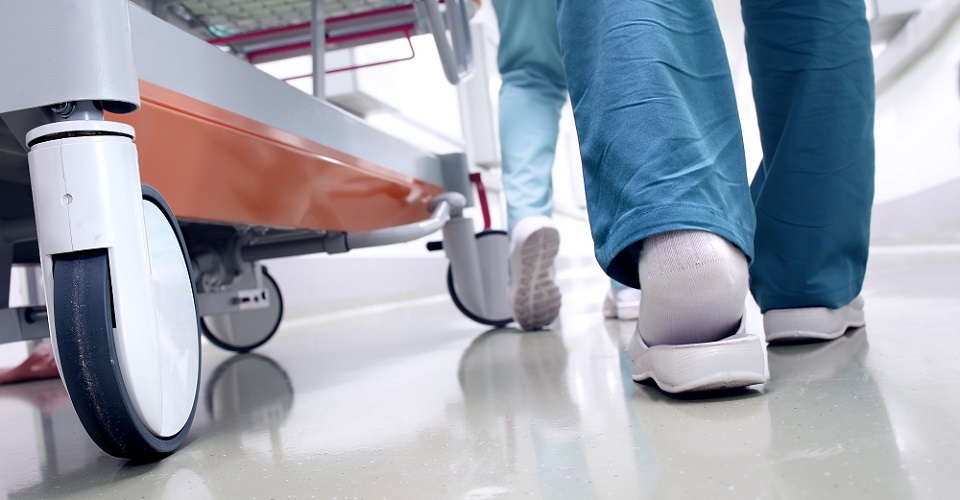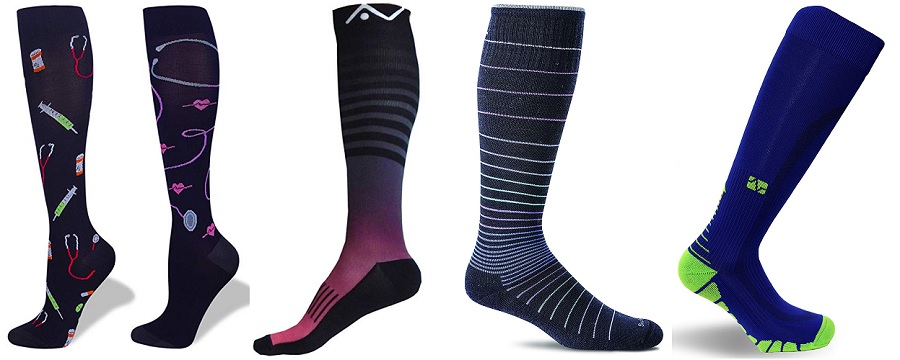
Our Editors independently research, test, and rate what we feel are the best products. We use affiliate links and may receive a small commission on purchases.
As a nurse, you already know how difficult a job you have. Caring for many patients when they’re sick or injured, and always putting those patients first can be rewarding but also physically draining.
However, the more physically demanding parts of your job, such as standing on your feet for 12 or more hours a day, can be mitigated with the use of compression socks.
The best nurses compression socks can help reduce the soreness of your feet after a long shift.
There are an astonishing number of compression socks that are designed for nurses who stand for a large part of their day and well cover the top rated socks to help you choose the right pair for you.
Let’s get started!
Quick Answer: The 7 Best Rated Compression Socks for Nurses
- Vitalsox Graduated Compression Sock
- BLITZU Compression Socks
- Sockwell Women’s Graduated Compression Socks
- Physix Gear Compression Socks
- A-Swift Compression Socks
- LEVSOX Compression Socks for Women
- Plain Jane Wide Calf Compression Socks
We’ve reviewed the top compression socks for nurses followed by a comparison table and buying guide to help you decide on a pair of socks that will work best for you.
Best Nurses Compression Socks
Compression Socks For Nurses Reviews
#1 Vitalsox Graduated Compression Socks
- Materials: Silver, Spandex, Lycra, Nylon
- Colors & Styles: 19
- Sizes Available: XS thru XL
- Compression: 12-20 mmHg
The Vitalsox are our Editor’s Choice as the best compression socks for nurses with their patented design of graduated compression that provides the wearer with a unique 4-way stretch that helps to deliver a comfortable experience.
The patented graduated design of these compression socks helps to create proper support for both the arch and the plantar ligament.
Using the benefits of several different materials, Vitalsox has created compression socks that help to wick away moisture, is naturally resistant to bacteria, and helps to minimize or prevent foot odor.
Not only are the materials Vitalsox has chosen for these patented graduated compression socks very comfortable, but they are also made using recyclable materials and are environmentally friendly.
When you receive your Vitalsox compression socks, you can try them on right out of the box, as they are pre-washed with a fabric softener containing no irritating chemicals.
#2 Blitzu Compression Socks
- Materials: Spandex, Lycra, Polyester
- Colors & Styles: 6
- Sizes Available: S/M and L/XL
- Compression: 20-30 mmHg
These compression socks by Blitzu are designed to fit both men and women in a variety of situations, such as those in the medical profession, those who work in offices, athletes, and even pregnant women.
Similar to the Vitalsox compression socks above, these Blitzu socks are graduated. The graduation starts just above the ankle. These compression socks utilize technology used during Kinesiology Taping that helps to provide stability while the fabric provides compression.
The compression fabric used in these Blitzu compression socks provides a 360-degree stretch so they fit comfortably but you still have a great deal of flexibility.
This makes them perfect for those who want to wear them every day, all day. The toe area is specifically designed not to squeeze your toes or the ball of your foot, which can make them even more comfortable.
#3 Compressionz Compression Socks
- Materials: Wool, Silver
- Colors & Styles: 17
- Sizes Available: S/M and M/L
- Compression: 15-20 mmHg
The compression socks by Compressionz are also graduated. You’ll find the strongest compression around the ankle, which helps with stability for those with weak ankles, and the compression gradually decreases until just below the knee.
They are designed for everyday wear for those who are active, whether on your feet all day as a nurse, or for those who participate in high-intensity activities, such as runners.
Compressionz socks are made in the US out of wool that is treated so it’s antibacterial and anti-odor. They provide a moderate about a graduated compression which is typical for compression socks that are used daily.
Spandex is woven throughout the sock which helps it to keep the strength of compression even after long-term wear.
#4 Phyzix Gear Compression Socks
- Materials: Not Listed
- Colors & Styles: 18
- Sizes Available: S/M and L/XL
- Compression: 20-30 mmHg
Physix Gear has designed compression socks that fit both men and women. These compression socks are graduated but offer a bit more compression then the ones reviewed above.
These Physix Gear compression socks help to target the muscles in the foot and calf, giving them the support they need through long hours on your feet.
These socks are designed with a breathable fabric that will dry quickly and is antibacterial. It wicks away sweat to make them more comfortable and can also reduce foot odor. The double stitching ensures a durable, reliable fit whether you on your feet for 2 hours or 12.
They come in several styles, so you can show off a bit of your personality while also making sure that your feet, ankles, and lower legs are healthy by wearing the best support socks for nurses!
#5 A-Swift Compression Socks
- Materials: Silver & Others
- Colors & Styles: 35
- Sizes Available: S thru L
- Compression: 20-30 mmHg
The A-Swift compression socks are designed for both men and women who intend on wearing them daily but need a higher level of compression.
They are designed to give reliable compression throughout the day. They can help reduce swelling and relieve pain from plantar fasciitis, shin splints, and more.
The breathable fabric is designed with yarn that has been infused with silver. This helps to make them antibacterial as well as anti-odor.
One of the most fun things about A-Swift is that they’ve designed their compression socks in many styles, from solids to patterns, so you can choose to dress a little more professionally, or you can have fun with your wardrobe.
#6 Levsox Compression Socks
- Materials: Not Listed
- Colors & Styles: 4
- Sizes Available: M & L
- Compression: 20-30 mmHg
Something that sets Levsox compression socks apart from the others on this list is they have a seamless design which makes them more comfortable, especially when worn for 12+ hours.
They are also made of a thinner material so wearing them in the summer or even with dress shoes won’t be a problem for most. These socks give all the support you need in the foot, ankle, and calf, but are also designed not to squeeze your toes.
This brand of compression socks are offered in many designs specifically for nurses, including heart rate, and heart rate with hearts, not to mention many more.
These socks give you all the benefits of wearing them but you’re also able to show off the passion you have for your profession. If you are looking for the best socks for nurses, the Levsox are a good choice!
#7 Plain Jane Wide Calf Compression Socks
- Materials: Not Listed
- Colors & Styles: 4
- Sizes Available: S/M & M/L
- Compression: 15-25 mmHg
Compression socks can be quite uncomfortable for those who have larger calves, whether it be from exercise, weight, or lack of activity.
These Plain Jane wide-calf compression socks give you all the benefits of wearing compression socks without being uncomfortably tight. They offer graduated compression that is stronger at the ankle and is less firm than some other options.
If you don’t need very firm compression but still need comfortable everyday wear, these plus-size compression socks from Plain Jane are perfect.
Not only do they offer all the benefits moderate compression, but they’re also designed to provide support for the foot and ankle. Compared to other compression socks of this size and style, the fabric is a little thicker. This may make them more comfortable for you with added cushion.
If you like your regular socks thicker for either warmth or comfort and want to invest in a pair of compression socks, these are ideal
Nurse’s Compression Socks Comparison Table
How to Choose the Best Nurses Compression Socks – Buying Guide

When it comes to compression socks for nurses, it’s important to choose the right ons for you. The same compression socks that work for your colleague may not work for you. Here, we give you several factors to consider when choosing from our compression socks reviews.
Graduated vs. Even Pressure
All of the compression socks reviews in this guide feature graduated pressures. Most of them have the highest amount of compression starting at the ankle and gradually decrease as they get nearer to your knee.
However, the Vitalsox patented graduated compression socks have the highest amount of compression starting in the mid-foot region.
The reason why we prefer graduated compression socks is they can have a greater effect on circulation in the lower leg, especially when compared to compression socks that offer even pressure from toe to knee. They also tend to be more comfortable.
Price vs. Value
You may think you are getting a good deal when purchasing some of the more inexpensive compression socks available, but while you’re saving money you may not be getting the quality you need.
This means that inexpensive does not necessarily mean great value. It’s important to choose the best compression socks based on the factors that make them perfect for your needs and will give you the best results.
Compression Socks vs. Sleeves
Compression socks typically cover the entire foot and go up to just below the knee. Compression sleeves, however, start at just below the ankle and stop just below the knee.
Sleeves may be a bit more comfortable at first but compression socks seem to work a lot better for those who are standing on their feet all day. A compression sock can help increase blood flow from the feet up, while a sleeve may not give the same result.
Sizing
Choosing the right size of compression sock is very important. If it is too tight it may cut off circulation and cause discomfort, and if it is too loose you won’t see the benefits of wearing them.
The sizing for every brand is a bit different. Sometimes they go based on shoe size and sometimes the sizes are based on the circumference of your calf. Either way, be sure to choose the size that is most appropriate.
Amount of Pressure
Compression socks come in varying levels of compression. The Vitalsox patented graduated compression socks start at just 12 mmHg in both the foot and the top of the sock near your knee, and go up to 20 mmHg at the widest area of the calf.
Several of the compression socks we’ve reviewed go up to 30 mmHg. But how do you know what level of compression is right for you?
It is recommended if you haven’t worn compression stockings before to start with a lower level of compression. This is because wearing them can take some getting used to and you don’t want to be uncomfortable. If you’re uncomfortable, you won’t wear them which means you won’t see the benefits.
Benefits of Compression Socks for Nurses
Whether wearing compression socks was recommended to you by a fellow co-worker, your own doctor, or you just saw the benefits for your patients, it’s important to know what the benefits are. When standing on your feet all day, the best compression socks will help in several ways.
Reduce Soreness
Being on your feet all day is just part of being a nurse, but that can also mean by the end of your shift your feet are sore. Compression socks can help reduce or even eliminate the soreness that you feel after a long shift.
But how does it work?
Compression socks for nurses help to increase circulation both to and from the feet. This brings more oxygenated blood to your feet and lower leg which reduces soreness but also reduces swelling.
Reduce Swelling in the Legs
It’s not just nurses that find themselves with swollen feet at the end of the day. Retail workers that work long hours, laborers in both construction and manufacturing industries, and others all feel the effects of being on their feet all day.
The compression offered with the best compression socks helps to keep swelling down by circulating it away from your feet. With less swelling in your feet and ankles, you will naturally feel less pain and soreness at the end of the day.
Reduce the Risk for and Appearance of Varicose Veins
One of the biggest risk factors for varicose veins is being on your feet for long hours at a time. One way you can help reduce the risk is by wearing the best compression socks. These socks will help keep blood from pooling in weaker areas of your veins in the lower legs.
Varicose veins don’t just cause pain, especially as we age, but may also make you self-conscious of the appearance. Why not do what you can to prevent varicose veins with compression socks?

FAQs About Compression Socks For Nurses
It’s common to have questions about compression socks if you’ve never worn them before and you don’t know much about them. These are the most common questions we’ve received when it comes to socks for nurses. If you have any additional questions be sure to let us know.
Q: How much compression do I need?
A: We mentioned above that compression socks come with varying levels of compression. But how do you know how much compression you really need? Let’s take a look.
Mild – 8 to 15 mmHg
Compression socks with mild compression can help to minimize the aches and pains of being on your feet all day. They may also help minimize fatigue as well as reduce minor swelling in the feet and ankles.
Medium – 15 to 20 mmHg
If you’re looking for a bit more compression, this level can help to prevent as well as provide relief of minor varicose veins. They also help with chronic swelling and can prevent deep vein thrombosis, also known as DVT. This is the recommended level of compression for those who are just starting to wear compression socks.
Firm – 20 to 30 mmHg
Several of the compression socks we’ve reviewed for you have a compression level of between 20 and 30 mmHg. These are intended to help prevent or relieve varicose veins that are moderate to severe. It’s also best for severe swelling and very sore feet and ankles. This is the highest level of compression that is usually recommended for nurses.
Extra Firm & Prescription Compression Levels
Compression socks also come and extra firm and prescription levels. These are typically used for more serious foot, ankle, and leg issues such as acute swelling, severe varicose veins, and deep vein thrombosis. These are often used after major surgery to prevent the formation of clots in the legs.
What compression do you feel would be best for you?
Q: Who benefits from compression socks?
A: Those in the medical profession are not the only ones who benefit from wearing the best compression socks. They are also recommended for athletes, those who sit for long periods of time while traveling, and even pregnant women. They are also recommended for those who have just had surgery as well as those with limited mobility.
Q: How do compression socks work?
A: With compression on your feet, ankles, and lower legs your blood vessels are forced to work better, which helps to increase circulation. Think of the compression as giving the veins a little bit of help when pushing the blood back to your heart.
The more blood that gets back to your heart and lungs means that many areas of your body will receive more oxygenated blood. Even mild compression can help keep your feet from getting sore and your feet and ankles from swelling.
Graduated compression socks can be even more beneficial due to the fact that they are tighter in the areas where swelling tends to be most common, which is in the ankle. Swollen ankles can even lead to injuries in the foot and ankle. Preventing swelling is important, especially for those who are always on their feet and moving.
Q: Can I wear compression socks that are fun?
A: Most of the time, your workplace won’t have restrictions on the type or style of socks that you wear. This is usually because they are not seen by the patients so you can have a little bit of fun with the design of your new compression socks.
The Levsox brand reviewed above even come with designs such as heartbeats, or even heartbeats with hearts in them. Many brands we’ve listed also come in various colors that suit both men and women. Whether you choose hearts or animals, or you keep it a bit more professional with black, blue, or brown, you will find exactly the design you desire..
Q: Will compression socks help my sore feet?
A: One of the biggest reasons why nurses choose to wear compression socks while at work is because they are very effective in reducing the soreness felt after a long shift. The improved circulation helps to make standing on your feet for long hours much more comfortable.
Tips For Fitting and Wearing Compression Socks
You’ve decided that as a nurse, you will benefit from the best compression socks available. But how do you get the most out of them? The following 5 tips can help you do just that.
Tip #1: Wear Compression Socks Properly
It’s important to put your compression socks on properly, and make sure they fit properly throughout the day. When putting on your socks, be sure you remove any jewelry such as rings and bracelets, that may snag the fabric.
With your thumbs inside the sock, bunch it up in your hands all the way to the toes. Place your toes into the sock, and slowly pull it around your heel and up to your knee as you gradually let go of the sock in your hands.
if you try to pull the sock up without starting from the toe, you may stretch it to the point that it snags or rips. It may stretch enough to reduce the level of compression you feel.
Tip #2: Use Compression Socks with Proper Footwear
The type of socks you wear each day can’t do all the work of reducing soreness and swelling. You also need to wear the right footwear that’s designed for those on their feet all day, especially nurses. We have reviewed some of the best shoes for nurses, and matching the right compression socks with the right shoes can help you feel better at the end of the day.
Tip #3: Take Care of Your Feet After Every Shift
Still, wearing the best socks with the best shoes can still only do so much. It’s important for you to take care of your feet after every shift to keep them as healthy as possible. But how do you care for your feet as a nurse? Here are some ideas.
- You should stretch before, during, and after your shift. Be sure to focus on your feet and legs.
- You can always give your lower legs and feet a massage. However, having a loved one do it for you helps even more. You may also want to set up a recurring appointment with a massage therapist.
- Cold Therapy. Ice helps to reduce swelling and inflammation, as you very well may know as a nurse. Your patients aren’t the only ones that can use ice to help ease soreness or pain. Make cold therapy a part of your regular after-shift routine.
- If you don’t have time to lay on the couch or in bed, or even in a recliner, to help elevate your feet when you get home from work, you may want to invest in extra pillows or even a foam wedge to help elevate your feet while sleeping.
- There are many types of bubble baths, bath salts, soaps, and lotions that help to relieve the swelling and soreness in your feet, ankles, and legs. Spoiling yourself with a long, hot bath or shower can also help you mentally decompress from a long or particularly hard shift.
Tip #4: Choose the Right Size and Level of Compression
It’s important to choose the right size of a compression sock. If the sock is too tight they can be very uncomfortable and may even cut off circulation which can cause pain. If the sock is too loose, you won’t see the benefits of investing in the best compression socks..
Whether the brand you are considering uses your shoe size or the measurement in centimeters around your calf, be sure you are using the correct measurements. Sizing charts are usually available. If you order a certain size and it is not correct, don’t give up. Either order another size of the same brand or choose another brand that may fit you better.
It is recommended that if you’ve never worn compression socks before that you start off with mild compression. The best choice that we’ve reviewed is the Vitalsox patented graduated compression socks for both men and women. The levels of compression for each type that we’ve listed in our top 7 compression socks for nurses are given above.
Tip #5: Take Your Time Finding the Right Brand, Style, and Size
We’ve mentioned that if you invest in a brand, style, and size of compression socks and they aren’t right for you, be sure to keep trying. When you find the right brand you will see the most benefit when wearing them.
Each brand that we’ve listed above in our review section, will fit differently, have different sizing, and even give you options for different styles. Finding the right compression socks is as important, and takes the same amount of trial-and-error, as choosing the right shoes.
Start Your Shift With Compression Stockings for Nurses
We’ve reviewed some of the best compression stockings for nurses. We hope the information in the buying guide, FAQs, and tips section will help you find the right pair for you.
As a nurse, we already know that you have a passion for your profession. Now you can enjoy all the passion of helping your patients while still keeping your feet, ankles, and calves as healthy as possible.
Notice:
HealthWellness365 is a participant in the Amazon Services LLC Associates Program, an affiliate advertising program. HealthWellness365 earns fees from products sold through qualifying purchases by linking to Amazon.com. Amazon offers a commission on products sold through their affiliate links.In March 2019 Amazon announced that Health Savings Accounts and Flexible Spending Accounts (HSA/FSA) would be accepted as new forms of payment for eligible product purchases. Using HSA/FSA funds to purchase on Amazon can be a great way to reduce taxes and reduce overall healthcare costs for items not covered under medical insurance. Users of such medical savings plans are issued a debit card by their provider, which can be added to their payment methods in their Amazon account.
Whether items sold on Amazon are deemed as eligible for HSA/FSA plans remains the responsibility of the buyer and their particular health plan provider. It’s ultimately up to the IRS and participating health plan providers to deem which medical and health products are considered eligible for the payment plans.
But the eligibility is quite broad and inclusive of thousands of products that are sold on Amazon and considered Health Savings and Flexible Spending Accounts plan-eligible. See this IRS document for more information about Health Savings and Flexible Spending Accounts: https://www.irs.gov/pub/irs-pdf/p969.pdf
